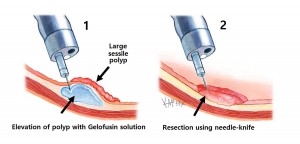-
drpvashistha@gmail.com
- +91 9004229819
Endoscopic Submucosal Dissection (ESD)
Endoscopic Submucosal Dissection (ESD) is a minimally invasive surgical technique used to remove abnormal tissues from the digestive tract, particularly in cases of early-stage cancers or precancerous lesions. Dr. Purushottam Vashishta, a renowned expert in Mumbai, specializes in performing ESD procedures with precision and care.
ESD is essential for several reasons. Firstly, it allows for the removal of lesions that are difficult to access through traditional surgery, reducing the need for more invasive procedures. Additionally, ESD enables the preservation of healthy surrounding tissue, minimizing potential complications and promoting faster recovery times for patients. Furthermore, ESD plays a crucial role in the early detection and treatment of gastrointestinal cancers, improving patient outcomes and survival rates.
Under the expert guidance of Dr. Purushottam Vashishta, ESD offers patients in Mumbai a safe and effective option for the management of gastrointestinal disorders, providing hope and healing through advanced medical interventions.
Why and when is Endoscopic Submucosal Dissection recommended?
Endoscopic Submucosal Dissection (ESD) is recommended for early-stage gastrointestinal cancers or precancerous lesions when traditional surgery is not feasible or poses higher risks. It's particularly beneficial when the lesion is small, localized, and confined to the superficial layers of the digestive tract. ESD offers precise, minimally invasive removal of abnormal tissue while preserving healthy surrounding areas. This technique is preferred for its lower complication rates, shorter hospital stays, and quicker recovery times compared to conventional surgery. ESD's effectiveness in early cancer detection and treatment makes it a valuable option for patients seeking less invasive therapeutic interventions.
Benefits of Endoscopic Submucosal Dissection (ESD)
- Minimally invasive: Requires small incisions, reducing trauma and promoting faster recovery.
- Preserves healthy tissue: Targeted removal minimizes damage to surrounding areas.
- Lower complication rates: Decreases risks compared to traditional surgery.
- Shorter hospital stays: Patients can often return home sooner after the procedure.
- Effective for early cancer: Enables precise removal of early-stage tumors, improving treatment outcomes.

